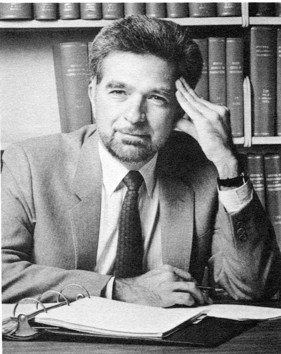First Demonstration That Tumor Necrosis Factor (TNF) Is Central to Disease Pathogenesis

Cerami, Anthony
Today scientists widely recognize tumor necrosis factor (TNF) as a molecule that sets off inflammation in autoimmune diseases such as rheumatoid arthritis, Crohn's disease, and psoriasis. Anti-TNF drugs developed in the 1990s are often prescribed to treat these conditions. But in the 1970s and early 1980s TNF was a molecule leading a double life. Researchers at Memorial Sloan-Kettering Cancer Center who were studying its ability to kill tumor cells had named it tumor necrosis factor. Soon thereafter, scientists at Rockefeller University led by Anthony Cerami (1940- ) were investigating a molecule they dubbed cachectin for its ability to cause cachexia--the wasting and weight loss associated with diseases like cancer and tuberculosis--in animals infected with trypanosomes. In 1985 the Rockefeller group made a surprising discovery: TNF and cachectin were one and the same.
Cerami, with Bruce Beutler (1957- ) and others, went on to show that blocking the action of TNF could prevent disease, and to propose that this effect could be used therapeutically. They studied a widely used model in which mice are injected with lipopolysaccharide (LPS), a component of certain bacteria, which is lethal and provokes a strong immune response. When the researchers neutralized TNF with antibodies in mice before giving the LPS, the mice were protected against the lethal effects of the LPS. This implicated TNF, a component of the mouse immune response, as a necessary mediator of the ill effects of LPS. Thus, instead of trying to kill tumors by administering TNF, scientists turned their attention to inhibiting TNF for therapeutic purposes.
TNF is now known to be a potent promotor of inflammation. Playing important roles both in innate immunity and in pathogenesis of infectious diseases, it has become one of the most studied of the cytokines--a class of proteins involved in cellular communication--and the subject of more than 60,000 scientific paper since 1975. Drugs that inhibit TNF, effectively curbing excess inflammation, have dramatically improved the treatment of rheumatoid arthritis and other autoimmune disease. Three of these drugs, sold under the names Remicade, Enbrel, and Humira, are licensed in the United States.
Anthony Cerami received the BS from Rutgers University, and the PhD from The Rockefeller University (1967). After postdoctoral work at Harvard Medical School and the Jackson Laboratory, he returned to Rockefeller in 1969. For 20 years Cerami headed the laboratory of medical biochemistry. He also served as dean of graduate and postgraduate studies. In 1991 he established the Picower Institute for Medical Research, and in 1996 he co-founded the Kenneth S. Warren Institute. Cerami, founder of Warren Pharmaceuticals, Inc., now serves as chairman and CEO of that company. He is developed hemoglobin A1c for monitoring glucose control in diabetes, and is the recipient of numerous awards, including the Luft Award in Diabetes and the Banting Medal for Scientific Achievement, from the American Diabetes Association.
Bruce A. Beutler received the BA from the University of California, San Diego (1976) and the MD from the University of Chicago (1981). After two years of additional medical training at the University of Texas Southwestern Medical Center in Dallas, he joined Rockefeller University in 1983. In 1986 Beutler returned to Dallas where he rose to the rank of professor, and became an an associate investigator of the Howard Hughes Medical Institute. In 2000 he joined the Scripps Research Institute, where he is professor and chairman of the department of genetics. Among many awards, he is the recipient of the Balzan Prize (2007). Beutler is an elected member of the American Society for Clinical Investigation, the Association of American Physicians, and the US National Academy of Sciences.
Selected Publications
Beutler B, Mahoney J, Le Trang N, Pekala P, and Cerami A. Purification of cachectin, a lipoprotein lipase-suppressing hormone secreted by endotoxin-induced RAW 264.7 cells. J Exp Med, 1985, 161: 984-995
Beutler B, Greenwald D, Hulmes JD, Chang M, Pan Y-CE, Mathison J, Ulevitch R, and Cerami A. Identity of tumour necrosis factor and the macrophage-secreted factor cachectin. Nature, 1985, 316: 552-554
Beutler B, Milsark IW, and Cerami A. Passive immunization against cachectin/tumor necrosis factor (TNF) protects mice from the lethal effect of endotoxin. Science, 1985, 229: 869-871
Tracey KJ, Beutler B, Lowry SF, Merryweather J, Wolpe S, Milsark IW, Hariri RJ, Fahey III TJ, A. Zentella, Albert JD, et al. Shock and tissue injury induced by recombinant human cachectin. Science, 1986, 234: 470 - 474
Further Reading
Vilcek J. First demonstration of the role of TNF in the pathogenesis of disease. J Immunol, 2008, 181: 5-6
Bashyam H. Uncovering the dark side of TNF. J Exp Med, 2007, 204: 2013
Clark IA. How TNF was recognized as a key mechanism of disease. Cytokine Growth Factor Rev, 2007, 18: 335-343
